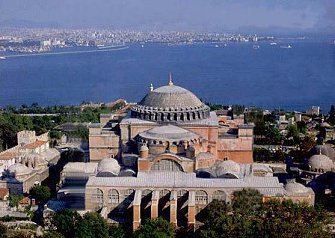Byzantium

|
|---|
| The Cathedral of the Holy Trinity, one of Byzantium's landmark monuments. |
Byzantium is the capital city of the Holy Socialist Republic of Constantinopolis. With over 14 million inhabitants, it is also the largest and most populated city in the country. Byzantium is a cultural, economic and administrative center of the highest importance. In addition, it holds the distinction of having never been conquered, at any point during its over 750 year-old history.
The modern city of Byzantium is located on both shores of the Strait of Kerphorus, which separates the Euxine Sea from the Sea of Propontis (see map). The historical city was built exclusively on the western shore; Byzantium only began to expand on the eastern shore in the 1930's.
The first written document that mentions the city of Byzantium dates to the year 1242. It is unknown when Byzantium was actually founded, but its legendary foundation date is January 15, 1154. Archaeological evidence does suggest that settlements have existed around the area of modern-day Byzantium in the 11th and 12th centuries; however, it is unclear whether one of these was the precursor of Byzantium or whether Byzantium was founded later. In any case, Byzantium enters the historical record in 1242 as the capital of a small voivodship ruled by a minor warlord (voivod). Over the next two hundred years, the power of the Voivods of Byzantium expanded, until Vladimir Ivanov the Great led a swift campaign of conquest that culminated with the establishment of Constantinopolis as a unified state, in 1436. Vladimir was crowned Basileus of Constantinopolis that year, and chose Byzantium as the capital of his new state. Byzantium has remained the capital of Constantinopolis ever since.
